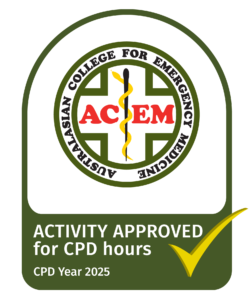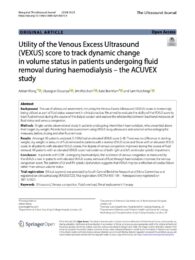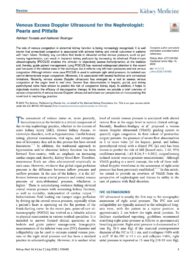
Nephrology
4 days
Nephrology Ultrasound Course
ACEM
Course highlights
- Renal Tract ultrasound including kidneys, bladder, and prostate.
- Advanced renal assessment including transplant kidneys, Doppler, and abdominal vasculature.
- Basic to advanced lung and cardiac ultrasound assessment.
- Venous Excess Ultrasound (VExUS) Score — incorporating VExUS and JVP ultrasound scanning techniques to determine fluid status and responsiveness.
- Ultrasound guidance in vascular access and procedures on phantoms.
Description
This comprehensive Point of Care Ultrasound Course for Nephrologists goes beyond ultrasound assessment of the renal tract. Extending Nephrologists during their hospital traineeship and beyond, this 4-day course teaches safe and effective renal and vascular ultrasound examinations that also integrate cardiac, lung and IVC into daily practice.
This includes VExUS scanning and integration, along with JVP assessment — to determine fluid volume status in management of fluid overload.
Ultrasound guidance in needle placement for cannulation, as well as interventional procedures such as renal biopsy are also incorporated.
We combine lectures and short demonstrations with lengthy hands-on practical scanning of real patient models. Students will engage in learning from acquisition and interpretation, through to integrating skills and knowledge into clinical situations and management.
Who should attend?
- Nephrologist
- Nephrology Trainee
- Internal Medicine Physician
- Intensive Care Physician
- Nurse Practitioner
- Palliative Medicine Physician
- General Physician
- ICU Registrar
- Junior House Officer
- Senior House Officer
Objectives
The objectives of this Ultrasound for Nephrology course are:
Renal Tract Ultrasound
- Recognise normal and abnormal appearances of the renal tract including kidneys, bladder, ureter and prostate.
- Identify common abnormalities, variants, and pathologies of the urinary tract.
- Perform scanning of the urinary tract including kidneys, bladder, prostate, aorta, IVC and other abdominal organs.
- Perform renal measurements and calculations including bladder pre and post void.
- Identify and perform Doppler assessment of kidneys and bladder.
- Identify advanced renal pathology and doppler appearances of renal ultrasound assessment.
Lung Ultrasound
- Identify normal and abnormal lung patterns.
- Recognise common abnormalities such as pneumothorax, consolidation, B lines, and atelectasis pleural effusion.
- Perform scanning of lung to a 12-point protocol.
- Integrate lung appearances in determination of fluid volume status.
Cardiac Ultrasound
- Acquire the 4 views of the heart — parasternal long axis (PLAX), parasternal short axis (PSAX), apical 4 chamber (AP4CH), and subxiphoid (SUBX) and the IVC.
- Identify normal appearances and size of the chambers, valves, cycle, heart, IVC, aorta and surroundings.
- Determine cardiac function by assessment of cardiac and chamber size, contractility, and dynamics.
- Perform advanced techniques in assessment of heart size, contractility, and function.
- Integrate cardiac appearances with lung and vein appearances to determine volume status.
VExUS and JVP Ultrasound
- Perform scanning and Doppler of IVC, hepatic veins, portal veins, and renal veins.
- Interpret Doppler waveforms of hepatic, portal, and renal veins.
- Integrate findings of VExUS scanning into context of volume status / venous congestion.
- Perform JVP measurement using ultrasound.
- Integrate VExUS and JVP ultrasound appearances into context for volume status and venous congestion.
Procedural and Ultrasound Needle Guidance
- Identify safe needle guidance techniques.
- Perform safe hygiene techniques in ultrasound needle guidance.
- Perform techniques of ultrasound needle guidance for vascular access and cannulation, and interventional such as renal biopsy.
- Perform renal biopsy techniques on renal phantoms.
Integrate appearances of cardiac, lung, IVC, VExUS and JVP ultrasound into identification of fluid volume status and congestion to determine appropriate management decisions.
Prerequisites
The prior ultrasound experience assumed for this course is highlighted below.
| None/Minimal | Don’t use ultrasound |
| Limited | Use ultrasound weekly/monthly |
| Moderate/Experienced | Use ultrasound daily/weekly |
Accreditation
 ACEM
ACEM
Approved for Educational Activities 31 hours.
Articles
The recent study “Utility of the Venous Excess Ultrasound (VEXUS) score to track dynamic change in volume status in patients undergoing fluid removal during haemodialysis – the ACUVEX study” by Wong et al. (March 27, 2024) underscores the critical role of ultrasound in dialysis patient care.
Read the articles below for more insights and stay ahead in nephrology with cutting-edge ultrasound techniques!
Utility of the Venous Excess Ultrasound (VEXUS) score to track dynamic change in volume status in patients undergoing fluid removal during haemodialysis – the ACUVEX study
Wong et al. The Ultrasound Journal, 27 March 2024

Venous Excess Doppler Ultrasound for the Nephrologist: Pearls and Pitfalls
Abhilash Koratala, MD, and Nathaniel Reisinger, MD, 19 May 2022


HOURS
| Theoretical | 10.5 |
| Practical | 16.5 |
| Total | 27 |


CATERING
Morning tea, a light lunch and refreshments are provided.
